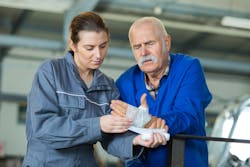Move over lagging standards, there’s a new measurement in town.
On April 29, the American Society of Safety Professionals (ASSP) announced that it has published a voluntary national consensus standard that outlines a different approach to measuring injuries. Typically companies measure safety and health performance by tracking incidents after the fact with lagging metrics. But this new standard is a balanced measurement approach, using leading, lagging and impact metrics, ASSP says. And the group feels this new standard can help organizations prevent injuries, illnesses and many other incidents from occurring in the first place.
The standard, ANSI/ASSP Z16.1-2022, Safety and Health Metrics and Performance Measures, incorporates a balanced evaluation of risk management factors and safety management systems that empowers a business to take a more comprehensive and effective approach to safety and health.
“Relying solely on lagging metrics does not improve workplace safety,” said Alexi Carli, M.S., CSP, chair of the Z16 committee, said in a statement. “We need a complete, systematic method to influence what happens while understanding how and why it happens. This standard’s balanced approach measures actions that drive improvement. It’s a major development that can help businesses thrive, especially in today’s challenging environment.”
“Occupational safety and health professionals are strategic business partners,” Carli added, “and the new standard enables them to help corporate leaders achieve greater organizational efficiencies and improve resilience.”
In addition to introducing a new standard, ASSP revised two standards that will also help advance workplace safety and health. Z117.1-2022, Safety Requirements for Entering Confined Spaces, provides minimum safety requirements to be followed while entering, exiting and working in confined spaces.
Confined space safety standards are critical across all industries because first responders may not have the capability to perform a rescue in all circumstances. Proactively implementing a standard such as Z117.1-2022 reduces risks such as oxygen deficiency, which is a leading atmospheric hazard in confined space incidents.
ANSI/ASSP A1264.2-2022, Reducing Slip Missteps on Walking-Working Surfaces, provides guidance for adequate slip resistance. Falls are the leading cause of accidental deaths in the United States. While these hazards exist in many work environments, organizations can take simple steps to mitigate or eliminate them.
Voluntary national consensus standards provide the latest expert guidance and fill gaps where federal regulations don’t exist. Companies rely on them to drive improvement and injury prevention. With regulatory requirements being slow to change and often out of date, compliance is not sufficient to protect workers.
About the Author
EHS Today Staff
EHS Today's editorial staff includes:
Dave Blanchard, Editor-in-Chief: During his career Dave has led the editorial management of many of Endeavor Business Media's best-known brands, including IndustryWeek, EHS Today, Material Handling & Logistics, Logistics Today, Supply Chain Technology News, and Business Finance. In addition, he serves as senior content director of the annual Safety Leadership Conference. With over 30 years of B2B media experience, Dave literally wrote the book on supply chain management, Supply Chain Management Best Practices (John Wiley & Sons, 2021), which has been translated into several languages and is currently in its third edition. He is a frequent speaker and moderator at major trade shows and conferences, and has won numerous awards for writing and editing. He is a voting member of the jury of the Logistics Hall of Fame, and is a graduate of Northern Illinois University.
Adrienne Selko, Senior Editor: In addition to her roles with EHS Today and the Safety Leadership Conference, Adrienne is also a senior editor at IndustryWeek and has written about many topics, with her current focus on workforce development strategies. She is also a senior editor at Material Handling & Logistics. Previously she was in corporate communications at a medical manufacturing company as well as a large regional bank. She is the author of Do I Have to Wear Garlic Around My Neck?, which made the Cleveland Plain Dealer's best sellers list.
Nicole Stempak, Managing Editor: Nicole Stempak is managing editor of EHS Today and conference content manager of the Safety Leadership Conference.
